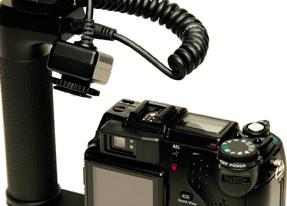The plague of point-and-shoot flash photography, red eye, can turn your children into demons and your pets into monsters. Here’s how to exorcise this curse from your life.
Red eye is caused by one of those laws of physics that’s difficult for point-and-shoot cameras to overcome. When the flash is located close to the camera lens and the subject’s iris is dilated in low, ambient room light, the flash sends a beam of light into the eye that’s reflected off the retina and beamed right back into the camera lens. Presto! You now have red eye.
Wedding photographers figured out a long time ago that if you move the flash away from the camera lens, preferably above it, you change the angle of reflection off the retina, so your camera lens doesn’t notice it. But adding an external flash isn’t always practical for many digicam-toting amateurs. So what are the alternatives?
I can tell you what the first alternative isn’t: the Red Eye Reduction mode on your camera. Most of these controls are based on the theory that if they can somehow constrict the irises of the subject’s eyes, red eye will be eliminated. As you know from your own experience, this doesn’t work very well. And you usually end up annoying your subjects by pelting them with strobes of light before the actual exposure.
But the concept of constricting the irises is viable. Instead of using Red Eye Reduction mode, however, try turning up the room lights, as shown in Figure 4-2. Also, if a lamp or other bright source is nearby, have the subject stare at that for a few seconds, then turn back to you for the picture. Both of these methods better achieve what Red Eye Reduction mode is trying to do, and with far less aggravation for everyone concerned.
Another trick is to have the subject look off to the side slightly and not gaze directly into the camera lens. This changes the angle of reflection and works most of the time.
If your camera accepts an external flash, then consider getting a dedicated flash cord (see Figure 4-3) so that you can raise the flash above the lens. This is far and away the most effective method for preventing red eye. You can simply hold the flash above the camera and shoot, but over the course of the evening, you will be much more comfortable by mounting the flash on a bracket.
You’ll also enjoy the added benefit of lowering those unsightly shadows cast by your subjects so they don’t appear on nearby walls. Extension-cord flash photography is one of the easiest ways to shoot like a pro indoors.
If your camera has a flash hot shoe— a holder on the camera to mount the flash, as shown in Figure 4-3—then chances are good that the manufacturer makes a flash and extension cord for your model. If not, take a look at the next hack for tips on how to add this functionality to your digicam.
It’s true, red eye is a monster. But you don’t have to let it terrorize your photography if you take a few easy steps to tame it.
Get Digital Photography Hacks now with the O’Reilly learning platform.
O’Reilly members experience books, live events, courses curated by job role, and more from O’Reilly and nearly 200 top publishers.



